








 |
Contact Us | Location | About Us | Pricing | T's & C's | ||||||||
 |
 |
 |
 |
 |
 |
 |
 |
||
Ideas In2 Action are proud to be able to provide you with a design solution that uses a PIC microcontroller as the heart of the system.
We have extensive experience of working with PICs and can provide you with either a ready made working prototype as your design solution, or can provide a training course for you (or your school students) to enable you to undertake electronic designs using PICs.
Most modern electronic products such as a washing machine, microwave, toaster, intelligent lighting system and dishwasher probably contain a PIC as the ‘brain’ of their system.
PIC is a family of Harvard architecture microcontrollers made by Microchip Technology, originally developed by General Instrument's Microelectronics Division. The acronym PIC refers to "Programmable Interface Controller".
PICs are popular with developers and hobbyists alike due to their low cost, wide availability, large user base, extensive collection of application notes, availability of low cost or free development tools, and serial programming (and re-programming with flash memory) capability.
 |
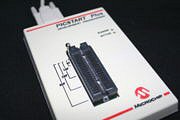 |
| Some of the Microchip PIC family | A traditional Serial PIC programmer |
Devices called "programmers" are traditionally used to get program code into the target PIC. Most PICs that Microchip currently sell feature ICSP (In Circuit Serial Programming) and/or LVP (Low Voltage Programming) capabilities, allowing the PIC to be programmed while it is sitting in the target circuit.
There are many programmers for PIC microcontrollers, ranging from the extremely simple designs which rely on ICSP to allow direct download of code from a host computer, to intelligent programmers that can verify the device at several supply voltages. Many of these complex programmers use a pre-programmed PIC themselves to send the programming commands to the PIC that is to be programmed. The intelligent type of programmer is needed to program earlier PIC models (mostly EPROM type) which do not support in-circuit programming.
Many of the higher end flash based PICs can also self-program (write to their own program memory). Demo boards are available with a small bootloader factory programmed that can be used to load user programs over an interface such as RS-232 or USB, thus obviating the need for a programmer device. Alternatively there is bootloader firmware available that the user can load onto the PIC using ICSP. The advantages of a bootloader over ICSP is the far superior programming speeds, immediate program execution following programming, and the ability to both debug and program using the same cable.
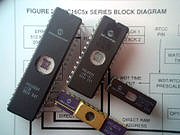 |
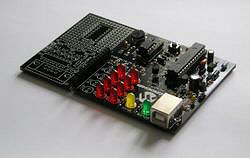 |
| Early types of EPROM based PICs | A typical PIC Development Board |
 |
| Basic Stamp 2 |
Many schools and hobbyists find traditional PIC programming languages difficult to understand and teach to their students. To overcome this a number of companies have developed systems which modify PICs to include ‘bootstrap files’ that make programming simpler. In these systems programming is undertaken either using a flowcharting system or is done using some form of BASIC language.
The BASIC Stamp was the first of these sytems that appeared on the educational market. It is a microcontroller with a small, specialised BASIC interpreter (PBASIC) built into ROM. It is made by Parallax, Inc. and has been quite popular with electronics hobbyists since the early 1990s due to its low threshold of learning and ease of use due to its simple BASIC language.
PICAXE provided a real breakthrough in learning and teaching in UK schools and is the name of a UK system designed and marketed by Revolution Education. PICAXE is based on a range of Microchip PICs. There are 13 PICAXE variants of differing pin counts from 8 to 40 pins. Initially marketed for use in education and by electronics hobbyists, they are also used in commercial and technical fields, including rapid prototype development. All use pre-loaded factory bootstrap interpretation code to allow user generated programs to be downloaded using a simple RS-232 or USB interface The PICAXE system provides several advantages over the traditional methods of programming a microcontroller (by placing the chip in a programmer). Remember you do not need an expensive programmer to use the PICAXE system!
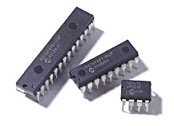 |
 |
| A selection of PICAXE I/Cs and a PICAXE controlled buggy | |
Cambridge based company, New Wave Concepts, has for many years been the leading publisher of electronics CAD software for education and industry. The flagship of their products is Circuit Wizard. New Wave Concepts have recently developed their own bootstrap based PIC product called Genie, which allows the circuit designer to develop PIC based products and simulate them on-screen before finally building the system. Circuit Wizard is used in thousands of schools, colleges and businesses around the world. New Wave Concepts products have a superb reputation for technological excellence and innovation.
 |
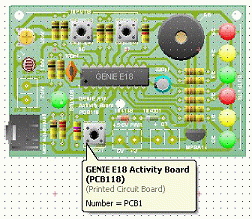 |
| New Wave Concepts Suite of Software |
Crocodile Clips' new Yenka simulator brings flowchart-based PIC and PICAXE simulation together with electronic schematics and PCB design. Based on the simulation engine used in well over half of the UK's secondary schools, it lets you design a PIC circuit, convert it to a 3D PCB simulation, and export your program to a real chip - all from one program. Free home licences for the full software are available to students and teachers from www.yenka.com.
| You can view an example of this system in the animation below. |
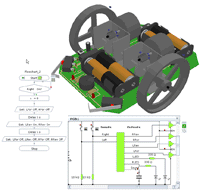 |
 PIC Logicator uses flowchart-based software for quick and easy programming of low-cost microcontroller chips. Logicator can be used to program all PICAXE chips and a range of standard PIC chips. 'Logicator for PIC micros' is the NEW name for 'PIC-Logicator'.
PIC Logicator uses flowchart-based software for quick and easy programming of low-cost microcontroller chips. Logicator can be used to program all PICAXE chips and a range of standard PIC chips. 'Logicator for PIC micros' is the NEW name for 'PIC-Logicator'.
Version 3 enhancements include:
New support for additional PICAXE parts, including the new low-cost 14M, 20M, 28X1 and 40X1 parts. The software now supports all available PICAXE chips – remember the new 14M and 20M support more features, at a lower price, than the original 18/18A chips!
New simulation engine to allow animations within the simulations. Several product simulations are provided with the software, and the ‘Simulation Studio’ development application is also included free of charge. This allows teachers to develop their own simulation based upon graphics or animations – e.g. take a photo of a class project and use the photo as the base for a simulation where LEDs flash, switches can be pushed etc.
The Technology Enhancement Programme (TEP) is about enriching and enhancing technology education through its training programmes and distinctive resources and ideas. TEP has supported, and in many cases pioneered the use of new technologies in schools e.g. PIC programming, robotics and control systems. TEP promotes and sources the use of a vast selection of modern and smart materials such as polymorph, thermochromic films and shape memory alloys. TEP is popularly known for developing desktop manufacturing resources, associated teaching and learning materials and supporting emerging technologies, such as nanotechnologies in schools and colleges. TEP PIC based products are:-
· Bit by Bit Controller |
|||
| This is a free standing working control board with 8 LED ‘flag’ outputs. The printed circuit board can be further populated to add transistor switched outputs or relay switched outputs. No computer required! The controller enables sequential control of up to eight outputs turning motors etc. on and off. A programme is entered literally bit by bit using small switches on the board itself - and can be run or modified any number of times. | 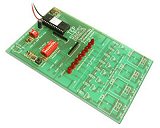 |
||
· The Chip Factory |
|||
| The Chip Factory is an extension of the Bit-by-Bit concept and is stand alone PIC programmer which enables the user to enter command lines using a simple bit pattern approach which then appears in the Liquid Crytal Display Screen .The PIC can then be removed from the system and placed in either a project board or a self designed project. |  |
||
| The Chip Factory Logic System (CFLS) is a software system developed for use with the TEP Chip Factory. It provides an easy to use graphical interface, which enables the user to create digital electronic circuit diagrams. (Not simply a flow diagram) CFLS converts these diagrams into a program language a PIC can understand and then program the PIC using the TEP Chip Factory. The Chip Factory Logic System provides another easy way to access the potentially phenomenal power of the PIC. | 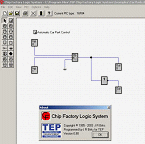 |
||
| · IQ System |
|||
| The IQ system provides simple on-board programming with virtually unlimited control opportunities and up to 248 lines of program The system has a non-volatile memory which allows retention of programs when switched off . The system board provides 2 inputs to control running of programs and 4 outputs giving direct drive of motors, lamps etc. (up to 800mA each output). As extra features the system provides direct stepper motor drive with speed and reverse capability and variable speed control of programs | |||
|
|||
Ideas in2 Action is able to provide training in the use of all, or some, of the above concepts. Hopefully we will be able to provide you with a cost-effective solution so that PICs can be used as a design tool for your applications. If you would like further details or discuss your specific needs please do not hesitate to contact us.
© Amethyst Consultancy. 2004-2020
For all products and systems designed by us on behalf of our clients the company's terms and conditions apply.